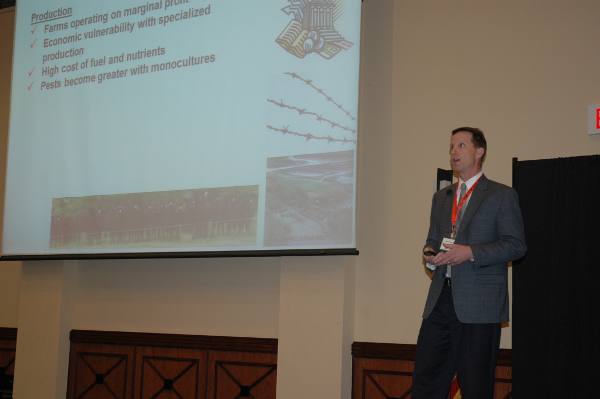
“Sustainability is not an end goal,” says Alan Franzluebbers, an ecologist with USDA’s Agricultural Research Service in Raleigh, N.C. “It’s a path.”
Farmers’ goals include productivity and profit, but protecting the environment is also important. More are doing that by converting to reduced tillage production practices, Franzluebbers said during a presentation to the annual No-till Oklahoma Conference in Norman.
“Farmers start with no-till systems,” he said. “Then they add cover crops over time to achieve sustainability goals. They need cover crops and a diverse rotation program that provides benefits to the soil and the crops.”
He’s worked with various systems in both North Carolina and previously at the USDA’s Watkinsville, Ga., research center near Athens and the University of Georgia campus. Diverse rotation systems have included corn and wheat with a clover cover crop; cotton, rye and peanuts; integrated crop and livestock systems; and agro-forestry or silva/pasture programs.
He said the climate around Watkinsville often includes water deficits in the summer and surpluses in the winter. He’s worked for several years on the interaction and the effect that livestock grazing on cover crops has on subsequent crop production.
Tillage systems
Also evaluated in the study are different tillage systems, including conventional tillage, short-term no-till and long-term no-till.
“Integrating livestock into crop production can create hardpan,” Franzluebbers said. “We wanted to assess cropping systems and compaction following grazing.”
He started with some assumptions, including that a cover crop would improve soil biochemical properties with or without grazing pressure while soil physical properties would be reduced.
Also assumed was that soil biological properties would be better with no-till and physical properties would be poorer with no-till.
Because of climate, yields in the studies were relatively low. Sorghum for grain yield was lower when the cover crop was grazed as was sorghum for forage. Conventional tillage yield was lower than with no-till.
“We saw no significant difference in corn yield between grazed and non-grazed but no-till production was greater than conventional till systems. We detected no significance between conventional tillage and no-till in winter wheat yields.”
He said cover crop production was better under no-till. “Also, we had greater cover crop biomass produced with application of fertilizers versus legume nutrients.”
A short-term no-till system provided some benefit but not as much as long-term no-till production.
“Summer grain crops were sometimes inhibited by spring grazing but wheat was unaffected by summer grazing of a cover crop. Long-term no-till resulted in better yields than short-term no-till.”
Adding livestock, he said, adds another dimension to row crop operations and may increase profit potential. “Overall production increased by 217 pounds, plus or minus 110 pounds per acre,” he said. “Cattle added $130 to $260 per acre in gross sales. Summer grazing allowed more grazing time.”
He said no-till proved beneficial to cattle grazing for winter and summer grazing regimes.
He also looked at soil responses to cattle grazing and found “no difference between grazed and non-grazed with either conventional or no-till production.”
He said short-term no-till may offer a better response if producers’ starting soil conditions are as good as possible. “Those starting conditions are important. Production is better if they start with good organic matter content.”
The study, Franzluebbers said, indicated several conclusions, including:
Cover crops (winter and summer) can provide high-quality forage and increase economic return and farm diversity, but farmers have been reluctant to take this advantage due to perceived “compaction” caused by animal trampling.
Rotation of crops following long-term pasture was highly effective in limiting (or avoiding) compaction with grazing cattle by maintaining the soil organic matter-enriched surface condition through subsequent no-tillage management.
Grazing cover crops does compact soils, but the measured response in soil was small. However, there was a noticeable effect of compaction on summer grain crops.
Grazing had little effect on bulk density under either tillage system—much less than lack of tillage when switching from conventional to no-tillage.
Grazing had essentially no effect on soil organic carbon content and depth distribution.
Grazing increased penetration resistance of the surface 4 inches of soil, discernible only under wet soil conditions.
Integrated crop-livestock systems that are productive and environmentally friendly can best be developed for the warm-moist Southeastern USA, with:
No-till management to preserve soil organic matter and buffer against animal traffic;
And strategic stocking of livestock on high-quality cover crops and crop residues.
Franzluebbers said farmers don’t get the credit they deserve from the general public for conserving soil and water on their farms. “The population should applaud farmers’ conservation efforts,” he said.
He also encouraged farmers to “be involved with environmental efforts and proclaim environmental stewardship.”
The efforts farmers make, he said, benefit not only their own farms but also the populations of rural communities. And as more farmers move further along the path of sustainability those benefits will only become greater.
If you are enjoying reading this article, please check out Southwest Farm Press Daily and get the latest news right to your inbox.
You may also like:
USCHI Urges Action to Reduce Regulatory Burden
Reduced tillage, increased residue preserves soil health
Panhandle crop production offers challenges to Oklahoma producers
About the Author(s)
You May Also Like






